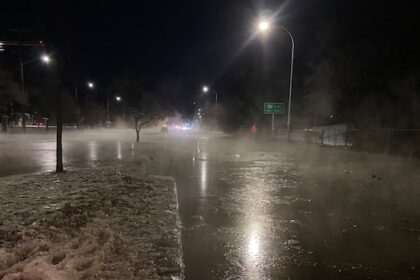When I ask Ricky Hicks about his business, he tells me about fishing. When I ask him about fishing, he says it’s so much bigger than business. “Fishing is life,” he says. Hicks’s business is a mobile tackle shop that he drags from the Northumberland Strait, which separates Prince Edward Island from Nova Scotia and New Brunswick, to the Bay of Fundy. “Wherever the fish are running,” Hicks says. “That’s where I’ll be.” One of the fish he follows is the striped bass, a once-threatened species that has made a dramatic comeback in Atlantic Canada. From collapsing salmon runs to dwindling smelt populations, the limits of the ecosystem are being tested, and some say the big fish are among the stressors. Federal regulators have reopened commercial access to striped bass — and a conservation triumph has become a flashpoint for the region’s ecological and economic future. Ricky Hicks has been fishing on Canada’s east coast for many years. He follows fish and their migration through the seasons and prides himself on knowing exactly where they will be at different times of the year. Hicks says he’s usually on the Shubenacadie River, north of Halifax, in the spring for the spawning season. Then he heads to the Bay of Fundy for the summer and back to the Shubenacadie before the fish migrate into the lakes for the winter. He makes a business of knowing where the fish are because he is supported by a network of striped bass anglers. “I sell them all the stuff that they need to be successful,” Hicks says. He teaches them what he learned through years of observation. “Bass are very temperature-temperamental. If it’s too cold they’re not moving. If it’s too warm they move offshore to cooler waters,” he says. Hicks sells bait to fishermen from as far away as Quebec and Maine, all travelling to Nova Scotia to catch striped bass. Federal moves on striped bass divide commercial and recreational fishermen The salmon fishery on the Miramichi River in New Brunswick has lured recreational anglers since at least the 19th century. The population on the river suffered as time went on, part of a trend Fisheries and Oceans Canada has tracked since the 1970s. Atlantic salmon populations declined by 68 per cent from 2003 to 2019 on the Miramichi, according to a research document prepared for the federal Committee on the Status of Endangered Wildlife in Canada in 2023.Factors affecting Atlantic salmon include high water temperatures, predators and other ecosystem changes caused by climate change and other human-induced pressures, the federal department told The Narwhal in an email. Martin Mallet, the executive director of the Maritime Fishermen’s Union, says among those pressures is the explosion of striped bass. Salmon fishermen aren’t among his members, but he says the massive predator species is affecting other commercial catches, including lobster, herring, mackerel, gaspereau and smelts. Striped bass are known for their distinctive horizontal stripes and can be found in both salt water and freshwater environments. The fish can live up to 30 years and grow to five feet long. Mallet says it’s not just a question of predation. Striped bass get tangled in fishing gear and damage equipment and it’s “creating havoc for our fishermen,” he says. In June, the Maritime Fishermen’s Union made an emergency request to Fisheries and Oceans Canada, asking the federal department to reopen the striped bass fishery for commercial bycatch — unwanted fish and marine creatures caught during commercial fishing for a different species — for the first time since 1996. The department complied: the order requires gaspereau harvesters to keep the first 500 striped bass caught each day between 50 and 65 centimetres and return the rest. At the same time, the department took other measures to manage striped bass stock. It reopened a section of the Northwest Miramichi River where striped bass spawn and raised the recreational limit on the Gulf of St. Lawrence from three to four fish per day. Fisheries and Oceans Canada also increased the Indigenous allocation of striped bass by 125,000 fish in July, an amount to be shared among First Nations in the gulf region, in addition to the 50,000 granted to Natoaganeg First Nation in 2018. Mallet says his union didn’t request an emergency bycatch measure to protect salmon, but to protect commercial fishermen and their livelihood. He says early in the season, fishermen were catching so many striped bass they had to throw back their whole catch, losing days of work. “These are expenses for our fishermen,” he says. “Direct losses to their business. So, by enabling our fishermen to keep a portion of the bycatch … our guys can sell those and recuperate their costs.” Striped bass are an enormous potential resource, he says, especially since bycatch fish released from lobster traps often die anyway. Mallet says the new regulations were a step in the right direction. “We still think we need to go a little bit further,” he says, adding that while the union wants a healthy fishery, he’s not out to “destroy the striped bass population.” “There’s a balance there that needs to be met. We did not have this predation five to 10 years ago,” he says. Mike Brideau, a fishing guide on the Miramichi, disagrees. Posting on Facebook about the federal order, he echoed the fears of striped bass anglers in New Brunswick. “Enjoy the fishery. It’s not going to be around forever,” Brideau wrote, warning the changes could crash the striped bass population. Striped bass made a big comeback. But are they safe? Brideau guides all over the province, living out of a tent to target different species for his clients, a nomadic lifestyle that is “part of the fun of the game.” He says he can adapt if bass stocks fail, but he thinks Fisheries and Oceans Canada doesn’t have any understanding of what fishermen remove from the water. “Anecdotally, I can already say I feel the bass are past their peak in growth [in population] due to our shift in regulations,” he told The Narwhal in an email. “There’s no way the population can withstand taking upwards of a third of itself year over year.” Tommi Linnansaari, the Atlantic salmon research chair at the University of New Brunswick, supports the re-opening of the commercial striped bass fishery as a pro-salmon move. “The predatory pressure could become large enough that the recovery of the salmon population is no longer possible,” he says. But he also says it’s unclear how much the striped bass population can shrink before triggering a catastrophic collapse like the one seen in the 1990s. He says the recreational fishery is a large “grey box,” since it is unlicensed and unmonitored and the impact of the increased First Nations quota and renewed commercial fishing won’t show up for at least a few years, as fishermen change their operations to accommodate new species. Striped bass spawn in the springtime along the Shubenacadie River in Nova Scotia, north of Halifax. For now, “I do support the striped bass harvest levels,” Linnansaari says. “I don’t know yet whether it could withstand a larger harvest but I do think that we should see how this plays out.”Trevor Avery is the head of the striped bass research team at Acadia University. He says the success of the species should be received with cautious optimism, especially since numbers are trending downward since the population peaked. “There’s a lot of them, but they only spawn in two places,” Avery says. “That level of threat is increased if their spawning area is impacted by humans or industry.” Striped bass may be threatened by overfishing, pollution and water flow changes that affect habitat, according to a Committee on the Status of Endangered Wildlife in Canada report from 2004. Better monitoring needed to identify true threats to Atlantic salmon Avery says it’s easier for federal and local management efforts to affect striped bass because it is a coastal species, while salmon are targeted by offshore industrial fishing operations across the globe. “Salmon go on these long treks, you know, up to Greenland or across to the U.K., and then they get vacuumed up in commercial fishing there,” he says. Fisheries and Oceans agrees, telling The Narwhal declining Atlantic salmon isn’t just a Miramichi River issue. Rivers throughout the eastern provinces, Quebec and Europe have seen substantial declines as well. That’s one reason Avery says he isn’t convinced striped bass is the problem. “In a lot of these rivers we don’t find striped bass,” Avery says. “So, this smoking gun, direct effect of saying striped bass are eating all the salmon on the Miramichi … may not be the full picture.” He adds that there were high populations of both salmon and striped bass in the past. “All that data is quite clearly there over the last 100 years,” he says. “It’s only recently that we have this mismatch in things where we have lots more striped bass and fewer salmon.” There’s debate among researchers and fishermen over whether striped bass, a species that spent several decades in decline, is contributing to the current decline in Atlantic salmon numbers. Salmon in eastern Canada face the combined threats of climate change, other predators and human-induced pressures. Photo: Ryan Hagerty / U.S. Fish & Wildlife Service Linnansaari and Avery both want better monitoring of Atlantic fish, including measuring environmental and industrial impacts. With proper management, Avery says he believes the populations can co-exist. “We don’t sacrifice one species for another. That’s not a conservation measure that has ever had any lasting good effects.” Across much of the eastern seaboard, striped bass conservation has become a rallying cry. In the United States, the fish is managed under the Atlantic States Marine Fisheries Commission through the Interstate Fishery Management Plan, supported by the federal Atlantic Striped Bass Conservation Act. When stocks decline, managers call emergency meetings, implement catch reductions and seasonal closures and tighten recreational and commercial rules. By contrast, in Atlantic Canada the recovery of the Gulf of St. Lawrence stock occurred under federal control, with limited public engagement and little regional coordination, the scientists say. After a decline in the 1990s, striped bass now proliferate again in the Northumberland Strait and the Bay of Fundy. In Brideau’s opinion, Fisheries and Oceans Canada should close the salmon fishery on the Miramichi, instead of “trying to say we need to critically intervene in nature through killing native species.” He says the major threats to salmon are clear: increasing water temperatures due to climate change, commercial angling, forestry — which can degrade salmon habitats by altering waterflow, nutrients and sediment — and aquaculture, which can spread pathogens such as sea lice from farmed salmon to wild populations. Every year, Brideau purchases a Crown reserve spot — a special fishing parcel in an area owned by the federal government, managed to control pressure on the fish population. He uses it to count the few salmon that remain, without catching any. “I have no interest in harassing a species that’s on life support,” he says. A house divided Linnansaari sees the current move to reduce the predatory species as just one of two potential solutions. The other is to supplement the prey. “We should actually increase the salmon population,” he says. This would encourage working together across fishing interests, and could be a more fertile approach, says Linnansaari. But that approach, too, is debated. The North Atlantic Salmon Conservation Organization has said supplementing salmon can compromise the fitness of wild populations through interbreeding and pathogens. It also won’t help commercial fishing that targets other species, like those the Maritime Fishermen’s Union focuses on. Avery agrees that progress depends on co-operation. “I think if we sit in two different camps, we’re going to stall,” Avery says. “Some people are in it for life,” says fisherman Ricky Hicks, whose fishing business is still going strong despite the political turmoil surrounding striped bass. Hicks manages his own business amid the politics. Today there are more than 35,000 members in the Nova Scotia Striped Bass Facebook group and 29,000 in the NB Striped Bass Sports Fishing group, all of them looking to join the exclusive 40-inch club by snagging a lunker. “I see a lot of new faces every year,” he says. “I do help them catch fish. I don’t just sell them fishing gear.” The idea is to get them hooked. “Some people are in it for life.” Recent Posts Fish fight: Is the decline of Atlantic salmon actually the fault of striped bass? Nov. 4, 2025 10 min. read A once-threatened fish has surged back while another one struggles — leaving fishermen, scientists and… Tiny birds, and their tiny superfood, could decline due to ‘irreversible’ effects of Vancouver port expansion Nov. 3, 2025 11 min. read The Fraser estuary is a major recharging stop for western sandpipers flying up the Pacific… Highway 413, Vancouver port expansion have the eye of the feds, newly released documents show Controversial initiatives appear among an internal list compiled by federal officials in March, showing 17…
Fish fight: Is the decline of Atlantic salmon actually the fault of striped bass?











